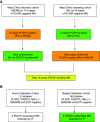Protocadherin 7-Associated Membranous Nephropathy
- PMID: 33833079
- PMCID: PMC8259689
- DOI: 10.1681/ASN.2020081165
Protocadherin 7-Associated Membranous Nephropathy
Abstract
Background: Membranous nephropathy (MN) results from deposition of antigen-antibody complexes along the glomerular basement membrane (GBM). PLA2R, THSD7A, NELL1, and SEMA3B account for 80%-90% of target antigens in MN.
Methods: We performed laser microdissection and mass spectrometry (MS/MS) in kidney biopsies from 135 individuals with PLA2R-negative MN, and used immunohistochemistry/immunofluorescence and confocal microscopy to confirm the MS/MS finding, detect additional cases, and localize the novel protein. We also performed MS/MS and immunohistochemistry on 116 controls and used immunofluorescence microscopy to screen biopsy samples from two validation cohorts. Western blot and elution studies were performed to detect antibodies in serum and biopsy tissue.
Results: MS/MS studies detected a unique protein, protocadherin 7 (PCDH7), in glomeruli of ten (5.7%) PLA2R-negative MN cases, which also were negative for PLA2R, THSD7A, EXT1/EXT2, NELL1, and SEMA3B. Spectral counts ranged from six to 24 (average 13.2 [SD 6.6]). MS/MS did not detect PCDH7 in controls (which included 28 PLA2R-positive cases). In all ten PCDH7-positive cases, immunohistochemistry showed bright granular staining along the GBM, which was absent in the remaining cases of PLA2R-negative MN and control cases. Four of 69 (5.8%) cases in the validation cohorts (all of which were negative for PLA2R, THSD7A, EXT1, NELL1, and SEMA3B) were PCDH7-positive MN. Kidney biopsy showed minimal complement deposition in 12 of the 14 PCDH7-associated cases. Confocal microscopy showed colocalization of PCDH7 and IgG along the GBM. Western blot analysis using sera from six patients showed antibodies to nonreduced PCDH7. Elution of IgG from frozen tissue of PCDH7-associated MN showed reactivity against PCDH7.
Conclusions: MN associated with the protocadherin PCDH7 appears to be a distinct, previously unidentified type of MN.
Keywords: glomerular disease; immunology and pathology; membranous nephropathy; nephrotic syndrome; renal biopsy; renal pathology.
Copyright © 2021 by the American Society of Nephrology.
Figures






Similar articles
-
Hematopoietic Stem Cell Transplant-Membranous Nephropathy Is Associated with Protocadherin FAT1.J Am Soc Nephrol. 2022 May;33(5):1033-1044. doi: 10.1681/ASN.2021111488. Epub 2022 Mar 23. J Am Soc Nephrol. 2022. PMID: 35321939 Free PMC article.
-
Membranous nephropathy-diagnosis and identification of target antigens.Nephrol Dial Transplant. 2024 Mar 27;39(4):600-606. doi: 10.1093/ndt/gfad227. Nephrol Dial Transplant. 2024. PMID: 37863839 Review.
-
Concurrent glomerular PCDH7 deposits in PLA2R-associated membranous nephropathy.CEN Case Rep. 2024 Aug;13(4):297-301. doi: 10.1007/s13730-023-00842-2. Epub 2023 Dec 25. CEN Case Rep. 2024. PMID: 38145434 Free PMC article.
-
A reliable clinical test for detection of membranous nephropathy antigens using laser microdissection and mass spectrometry.Kidney Int. 2024 Nov;106(5):907-912. doi: 10.1016/j.kint.2024.07.031. Epub 2024 Aug 26. Kidney Int. 2024. PMID: 39197586
-
New 'Antigens' in Membranous Nephropathy.J Am Soc Nephrol. 2021 Feb;32(2):268-278. doi: 10.1681/ASN.2020071082. Epub 2020 Dec 30. J Am Soc Nephrol. 2021. PMID: 33380523 Free PMC article. Review.
Cited by
-
Development and validation of a discrimination model between primary PLA2R-negative membranous nephropathy and minimal change disease confirmed by renal biopsy.Sci Rep. 2021 Sep 10;11(1):18064. doi: 10.1038/s41598-021-97517-8. Sci Rep. 2021. PMID: 34508140 Free PMC article.
-
Specific antigens in malignancy-associated membranous nephropathy.Front Med (Lausanne). 2024 Apr 15;11:1368457. doi: 10.3389/fmed.2024.1368457. eCollection 2024. Front Med (Lausanne). 2024. PMID: 38686366 Free PMC article. Review.
-
[Exploring the Role of PCDHGB4 in the Occurrence of Lung Squamous Cell Carcinoma Based on Bioinformatics Analysis].Zhongguo Fei Ai Za Zhi. 2024 Mar 20;27(3):199-215. doi: 10.3779/j.issn.1009-3419.2024.102.03. Zhongguo Fei Ai Za Zhi. 2024. PMID: 38590195 Free PMC article. Chinese.
-
Technology Innovation for Discovering Renal Autoantibodies in Autoimmune Conditions.Int J Mol Sci. 2024 Nov 25;25(23):12659. doi: 10.3390/ijms252312659. Int J Mol Sci. 2024. PMID: 39684370 Free PMC article. Review.
-
Membranous nephropathy: pathogenesis and treatments.MedComm (2020). 2024 Jun 29;5(7):e614. doi: 10.1002/mco2.614. eCollection 2024 Jul. MedComm (2020). 2024. PMID: 38948114 Free PMC article. Review.
References
-
- Ronco P, Debiec H: Pathophysiological advances in membranous nephropathy: Time for a shift in patient’s care. Lancet 385: 1983–1992, 2015. - PubMed
Publication types
MeSH terms
Substances
Grants and funding
LinkOut - more resources
Full Text Sources
Other Literature Sources
Miscellaneous

